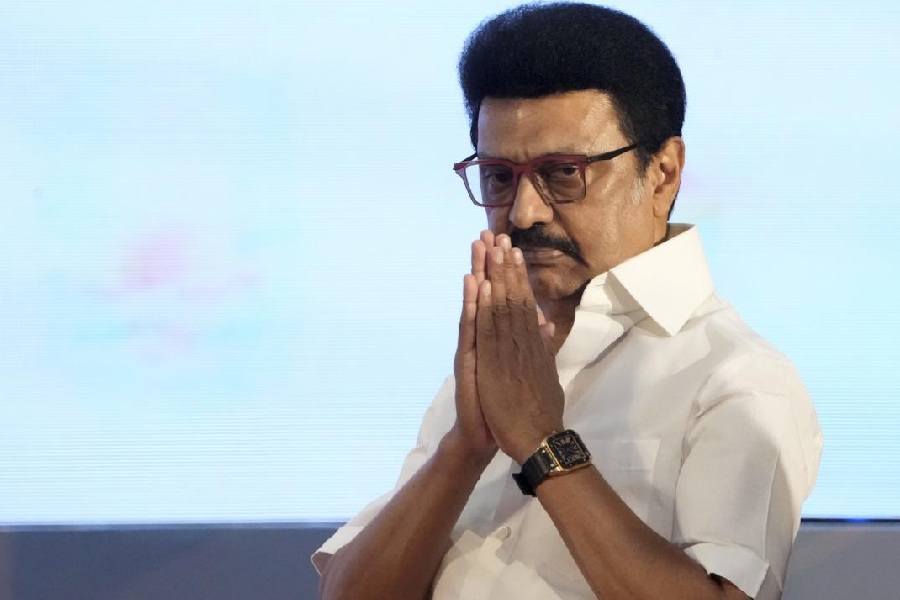 |
| SARI LOVERS: Elizabeth Hurley and Cherie Blair |
When the deputy prime minister’s wife, Miriam Clegg, wore a sari recently, the Spanish beauty looked stunning, the Daily Mail noted.
“You look starry in that sari Mrs Clegg: Miriam is pretty in pink at Asian Women of Achievement Awards show,” its headline read.
Miriam’s husband is Nick Clegg, the leader of the Liberal Democrats, the party that has formed a historic coalition government with David Cameron’s Tories.
Cameron’s wife, Samantha — “SamCam” to the tabloids — is a bit of a fashionista often spotted at catwalks. But Miriam, a lawyer who prefers to be known by her professional name, Miriam Gonzalez Durantez, usually likes to keep a low profile. But she came to the Asian function.
For 12 years, the awards have been run by a Calcutta woman, Pinky Lilani, whose own achievement has been to persuade women leaders in politics, business and the arts to come to her function in a sari.
 |
| Miriam Clegg |
Pinky normally gets a designer and shop to offer the women a choice of saris or ethnic wear and then helps them to put on the garments. Though it can be a tricky business keeping the sari on, all the women say they have felt transformed by the experience.
Some like Cherie Blair, who is a great supporter of Asian women, began coming when her husband, Tony Blair, was prime minister and has attended the awards ceremony on several occasions. It is safe to assume that her own wardrobe contains several items of Indian clothing.
Once, it was Labour women MPs who were more likely to be found wearing saris, possibly because they represented constituencies with a significant proportion of Indian, Pakistani or Bangladeshi voters. But today the sari cuts across party political lines. For example, among Tory women, Theresa May, currently the home secretary, has come to Pinky’s evenings more than once.
Last year Theresa came in a blue sari. This year, she wore a dark maroon Indian top and pyjamas. Basically, she does the same job as P. Chidambaram but clearly has not felt presenting a more feminine image in a sari undermines her role as the minister who has to take tough decisions when tackling terrorism. When entering 10, Downing Street to attend cabinet meetings, she sticks to normal western clothes. Theresa does have a reputation, though, for favouring sexy “kitten shoes”.
 |
| British-Indian designer Sharen Kaur in her award-winning “corset sari” |
If Indian food is the carrier of culture, so is the sari. Among those who have worn the sari or other Indian clothes to the awards are Baroness (Helen) Kennedy, a human rights lawyer; Tessa Jowell, an MP who was a senior minister under both Blair and Gordon Brown; and Patricia Hewitt, a former secretary of state for trade and industry, who is now chairman of the UK India business council, the body that promotes bilateral trade.
The Slumdog Millionaire actress Freida Pinto once announced the sari was not for her because she felt it would make her look old. No such inhibition is shown by British-born Indian, Pakistani and Bangladeshi women who realise that for special occasions, there is no garment as glamorous as the sari.
In its attitude to the sari, British society has itself undergone a radical change. The theatre director Jatinder Verma once revealed that when his mother was forced to work in a factory in the 1970s shortly after the family arrived from Kenya, the management reduced her to tears by insisting she would have to swap her sari for trousers.
Today, in the same Britain, top women are happy to pose for photographs dressed in saris.
There has even been an attempt to design a “British sari” that could appeal to non-Asians.
The scheme is that of an Englishwoman, Susan Roberts, who runs Bridging Arts, an organisation which uses arts to bring different cultures closer. Since 2007, she has run three competitions. Susan wrote about some of the entries in a book, British Asian Style: Fashion & Textiles/ Past & Present, published by V&A Museum in London.
The overall winner, writes Susan, was Nilesh Mistry, from Harrow, north London. “Tiny motifs of Harrow’s coat of arms cover the body of the sari. Centred on the pallu is Harrow’s famous hill, the public school and the church, all with the air of a bygone age. But Mistry wanted to draw out the contrast between old and new.... Beneath the ancient coat of arms, wild roses and public school boys in cricket flannels and boaters, the new citizens of Harrow march along the border... a Somali woman in a burqa, a hoodie with a mobile phone, a Gujarati housewife, a Polish builder and a mullah.”
Another year, there was an attempt to design bridal wear. By last year, a fashion student, Sharen Kaur, of Manchester, had designed a “corset sari” inspired by “the trousers women wore under their skirts when working in local coal mines”. According to the judges, her “breathtaking blue sari with a corset and leggings took the top prize in the competition for a sari reflecting British life today”.
Meanwhile, in Peterborough, a young Muslim woman, Zahra Ahmed, came up with a design so revealing — the mini-skirted sari — that she said she would not wear herself.
Susan thinks either of the designs would be perfect for a retail chain like Topshop which would take the sari into the mainstream.
“That would be fantastic,” declares Susan, who wants a supermodel such as Kate Moss to trigger a sari revolution simply by wearing one.
Incidentally, Susan is impressed with the deputy prime minister’s wife, Miriam Gonzalez Durantez, especially the narrowing “fish tail effect” at the bottom. “She is wearing it very well,” she says.
The Daily Mail also wondered whether Miriam would take more of an interest in fashion in an effort to support her husband’s career. “If so, then last night’s sari will be seen as a fantastic start,” the paper enthused.











